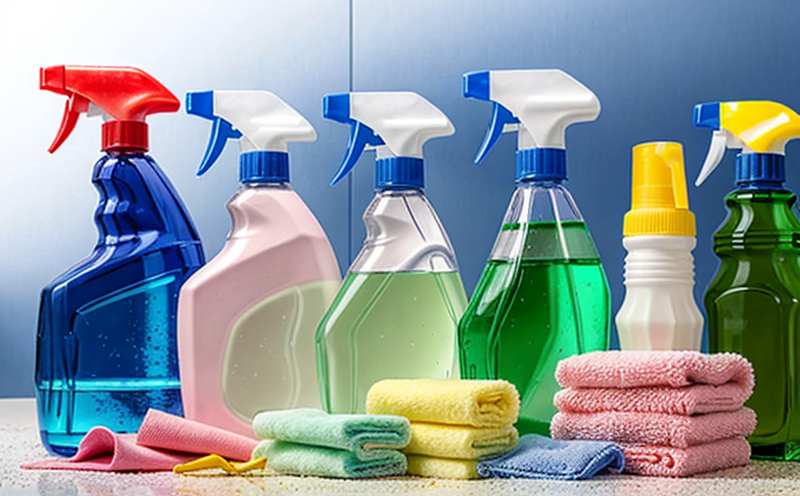Cleaning Performance Testing on Standard Stains
Consumer products and product safety testing is a critical aspect of ensuring that goods meet regulatory standards and consumer expectations. Within this sector, cleaning performance testing on standard stains plays a pivotal role in the development and quality assurance of detergents and household cleaning products. This service involves subjecting various types of stains to rigorous cleaning trials using standardized protocols. The objective is to assess the effectiveness of different cleaning agents under controlled conditions.
The testing process begins with selecting appropriate stains based on their common occurrence in real-world scenarios. These could include protein-based stains like blood and milk, fat-based stains such as grease and oil, and organic stains from fruits or vegetables. Each stain type has unique characteristics that challenge the cleaning agent's performance, thereby providing a comprehensive evaluation.
During specimen preparation, the stains are applied to test fabrics according to specified guidelines. The choice of fabric is crucial as it mimics the end-use conditions for detergents and cleaning products. Once prepared, these specimens undergo rigorous washing cycles using the specific detergent or cleaner being tested. The wash cycle parameters—such as water temperature, duration, and agitation—are strictly controlled to ensure consistency across all samples.
The performance of each cleaning agent is then evaluated against industry standards such as ISO 13279 for grease removal testing. This standard provides a framework for measuring the effectiveness of detergents in removing greasy stains from fabrics. Similarly, ASTM D5294 covers the evaluation of soiled and stained textiles by means of an accelerated laundering process.
After washing, the specimens are visually inspected for stain removal, with ratings assigned based on criteria like color fastness, fabric integrity, and overall cleanliness. Additionally, instrumental analysis may be conducted using techniques such as reflectance spectroscopy to quantify changes in the appearance or texture of the fabrics post-cleaning.
This comprehensive approach ensures that not only is the cleaning effectiveness assessed but also the impact on the product being cleaned. By adhering to these stringent protocols, manufacturers can optimize their formulations to meet both performance and safety requirements.
Applied Standards
The application of internationally recognized standards is essential for ensuring consistency and reliability in cleaning performance testing. Some key standards include:
- ISO 13279:2016 - Accelerated Grease Removal from Textiles.
- ASTM D5294-18 - Standard Practice for Evaluation of Soiled and Stained Textiles by Means of an Accelerated Laundering Process.
- EN 13673:2017 - Detergent for Laundry Use - Determination of Grease Removal Efficiency from Wool Fabrics.
- IEC 62458-2:2019 - Household Appliances - Washing Machines - Part 2: Performance Testing Methods.
These standards provide a standardized methodology for testing and evaluating cleaning performance, ensuring that results are comparable across different laboratories and manufacturers. Compliance with these guidelines is crucial not only for regulatory compliance but also for maintaining brand integrity and customer satisfaction.
Benefits
- Informed Formulation Development: By identifying effective cleaning agents through rigorous testing, manufacturers can refine their product formulations to enhance performance.
- Enhanced Consumer Confidence: Positive results from independent laboratories help build trust and confidence among consumers regarding the efficacy of cleaning products.
- Regulatory Compliance: Adherence to industry standards ensures that products meet regulatory requirements, mitigating potential legal issues.
- Improved Brand Reputation: Consistent high performance in cleaning tests enhances a brand's reputation and market position.
- Cost Efficiency: Early identification of suboptimal formulations can save time and resources by preventing costly rework during product development.
The benefits extend beyond just the manufacturer, as cleaner products contribute to better home environments and healthier living conditions. By leveraging this testing service, companies can stay ahead of market trends and regulatory changes, ensuring their products remain competitive in a dynamic industry landscape.
Industry Applications
Cleaning performance testing on standard stains is widely applicable across various sectors within consumer products:
- Detergent Manufacturers: Testing new formulas helps ensure that they meet or exceed market expectations for grease and stain removal.
- Laundry Appliances Manufacturers: The effectiveness of detergents in conjunction with washing machines can be assessed, optimizing appliance performance.
- Cleaning Supply Chains: Procurement teams rely on this testing to validate the quality and efficacy of products before finalizing contracts.
- R&D Engineers: This service allows for continuous improvement through iterative testing and analysis.
The insights gained from such tests are invaluable in driving innovation and maintaining high standards across the industry. It ensures that consumers receive products that not only meet but exceed expectations, contributing to a safer and more hygienic home environment.





